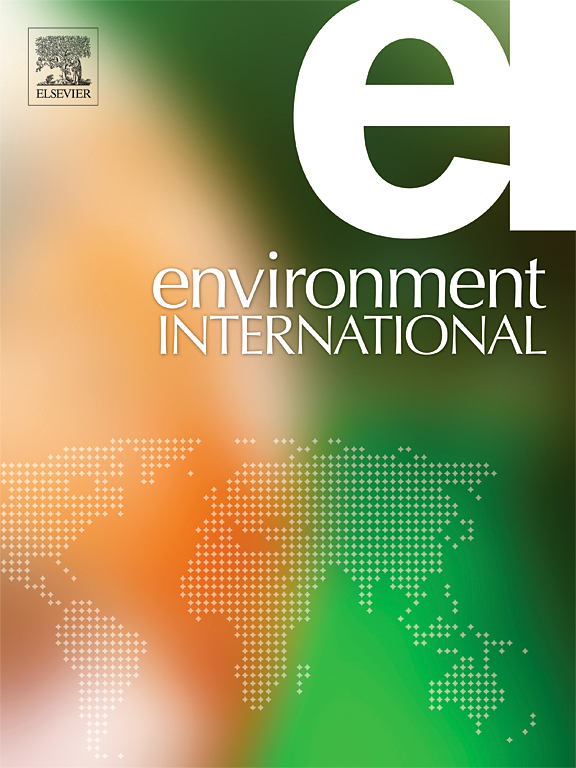Effect of maternal bisphenol exposure on adverse pregnancy and neonatal outcomes: The Japan Environment and Children’s study
IF 10.3
1区 环境科学与生态学
Q1 ENVIRONMENTAL SCIENCES
引用次数: 0
Abstract
Maternal exposure to bisphenols, including bisphenol A (BPA), reportedly results in adverse pregnancy and offspring health outcomes. However, large birth cohort studies on the risk of BPA exposure during pregnancy remain limited. Here, we examined bisphenols’ effects on adverse pregnancy and neonatal outcomes using data from the Japan Environment and Children’s Study, a nationwide birth cohort study.
We selected 4523 women with pregnancies resulting in singleton live births. First-trimester urine concentrations of bisphenols A, F, S, and AF were determined via high-performance liquid chromatography-tandem mass spectrometry. We analyzed the association between BPA exposure and preterm birth, hypertensive disorders of pregnancy, gestational diabetes mellitus, small- and large-for-gestational-age infants, low birth weight, offspring physical and chromosome abnormalities using Bayesian logistic regression analysis after applying the GSimp imputation method for concentrations within the minimum reporting limit.
Bisphenol detection rates were generally low (0.0–11.9 % of samples), except for that of BPA (71.5 %), and BPA concentrations were lower than those reported in previous international studies. The estimated BPA daily intake for 86.6 % of the study participants exceeded the European Food Safety Authority’s tolerable daily intake (0.0002 µg/kg/day). However, BPA intake was not significantly associated with any outcome.
These findings suggest that BPA’s current exposure levels do not affect measured pregnancy and neonate outcomes in Japan. Here, although BPA levels reflect only recent exposure, the potential health risks associated with BPA underscore the need for further research to investigate the long-term effects of low-level exposure on maternal and child health.


母体双酚暴露对不良妊娠和新生儿结局的影响:日本环境与儿童研究
据报道,母亲接触双酚类物质,包括双酚A (BPA),会导致不良的妊娠和后代健康后果。然而,关于怀孕期间BPA暴露风险的大型出生队列研究仍然有限。在这里,我们使用日本环境与儿童研究(一项全国性的出生队列研究)的数据,研究了双酚类物质对不良妊娠和新生儿结局的影响。我们选择了4523名怀孕导致单胎活产的妇女。采用高效液相色谱-串联质谱法测定孕早期尿中双酚A、F、S和AF的浓度。采用GSimp归算方法,对最低报告限度内的BPA暴露浓度进行贝叶斯logistic回归分析,分析BPA暴露与早产、妊娠高血压疾病、妊娠期糖尿病、小胎龄儿和大胎龄儿、低出生体重儿、后代体质和染色体异常的关系。双酚的检出率普遍较低(0 - 11.9 %),但双酚a的检出率为71.5 %,双酚a浓度低于国际上已有的研究报告。据估计,86.6% %的研究参与者的BPA每日摄入量超过了欧洲食品安全局的每日可耐受摄入量(0.0002 µg/kg/day)。然而,BPA摄入量与任何结果都没有显著关联。这些发现表明,BPA目前的暴露水平不会影响日本测量的怀孕和新生儿结局。在这里,尽管双酚a水平只反映了最近的暴露,但与双酚a相关的潜在健康风险强调了进一步研究低水平暴露对母婴健康的长期影响的必要性。
本文章由计算机程序翻译,如有差异,请以英文原文为准。
求助全文
约1分钟内获得全文
求助全文
来源期刊

Environment International
环境科学-环境科学
CiteScore
21.90
自引率
3.40%
发文量
734
审稿时长
2.8 months
期刊介绍:
Environmental Health publishes manuscripts focusing on critical aspects of environmental and occupational medicine, including studies in toxicology and epidemiology, to illuminate the human health implications of exposure to environmental hazards. The journal adopts an open-access model and practices open peer review.
It caters to scientists and practitioners across all environmental science domains, directly or indirectly impacting human health and well-being. With a commitment to enhancing the prevention of environmentally-related health risks, Environmental Health serves as a public health journal for the community and scientists engaged in matters of public health significance concerning the environment.
 求助内容:
求助内容: 应助结果提醒方式:
应助结果提醒方式:


